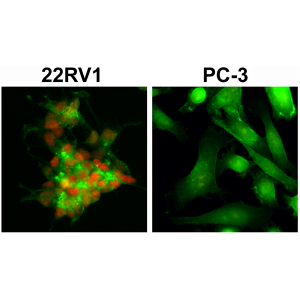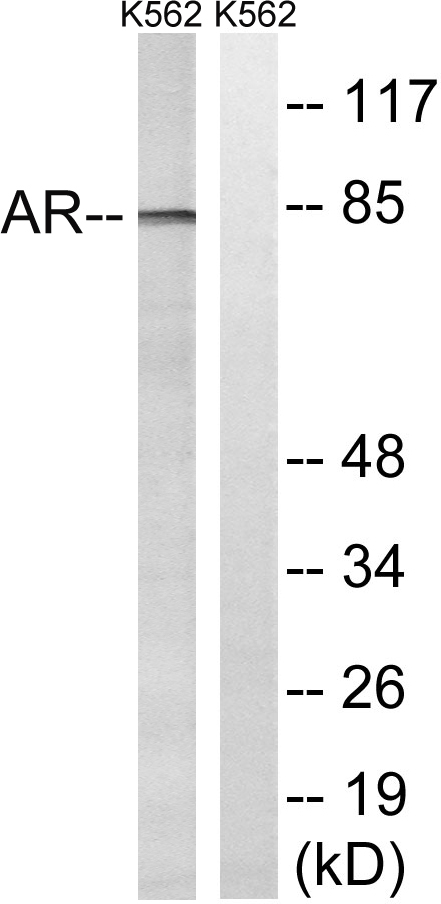
Immunocytochemical staining of 22RV1 and PC-3 cells, using anti-AR-V7 rabbit monoclonal Antibody Clone RM7 (red). Actin filaments have been labeled with fluorescein phalloidin (green).
anti-AR (ARv7 Splice Variant) (human), Rabbit Monoclonal (RM7)
REV-31-1109-00
ApplicationsWestern Blot, ImmunoCytoChemistry, ImmunoHistoChemistry
Product group Antibodies
ReactivityHuman
TargetAR
Overview
- SupplierRevMAb Biosciences
- Product Nameanti-AR (ARv7 Splice Variant) (human), Rabbit Monoclonal (RM7)
- Delivery Days Customer10
- ApplicationsWestern Blot, ImmunoCytoChemistry, ImmunoHistoChemistry
- CertificationResearch Use Only
- ClonalityMonoclonal
- Clone IDRM7
- Gene ID367
- Target nameAR
- Target descriptionandrogen receptor
- Target synonymsAIS, AR8, DHTR, HUMARA, HYSP1, KD, NR3C4, SBMA, SMAX1, TFM, androgen receptor, dihydrotestosterone receptor, nuclear receptor subfamily 3 group C member 4
- HostRabbit
- IsotypeIgG
- Protein IDP10275
- Protein NameAndrogen receptor
- Scientific DescriptionRecombinant Antibody. This antibody reacts to androgen receptor splice variant 7 (AR-V7). No cross reactivity with wild type androgen receptor. Applications: WB, ICC, IHC. Source: Rabbit. Liquid. 50% Glycerol/PBS with 1% BSA and 0.09% sodium azide. The androgen receptor (AR) is a member of the steroid-hormone receptor superfamily of nuclear receptors. The receptor is more than 90 kDa and has three major functional domains: the N-terminal domain, DNA-binding domain, and the androgen-binding domain. The androgen receptor is a ligand-activated transcription factor that binds active testosterone (T) and dihydrotestosterone (DHT). Upon binding the hormone ligand, the receptor dissociates from accessory proteins, translocates into the nucleus, dimerizes, and then stimulates transcription of androgen responsive genes. The AR signaling pathway plays a key role in development and function of male reproductive organs, including the prostate and epididymis. AR also plays a role in nonreproductive organs, such as muscle, hair follicles, and brain. Androgen Receptor is a phosphoprotein, and also regulates mitogen-activated protein kinase (MAP kinase). The inhibition of the MEK1/2 pathway correlates directly with a change in phosphorylation state of the androgen receptor. Abnormalities in the AR signaling pathway have been linked to a number of diseases, including prostate cancer, Kennedys disease, and male infertility. Mutations in this gene are associated with complete androgen insensitivity (CAIS). The AR3 or ARv7 isoform, which lacks the typical ligand binding domain, is created through the alternative splicing of cryptic exons. ARv7 is frequently expressed in castration-resistant prostate cancer (CRPC) and while dependent on the activity of the full-length androgen receptor (AR-FL), ARv7 can activate a completely distinct transcriptional program. - The androgen receptor (AR) is a member of the steroid-hormone receptor superfamily of nuclear receptors. The receptor is more than 90 kDa and has three major functional domains: the N-terminal domain, DNA-binding domain, and the androgen-binding domain. The androgen receptor is a ligand-activated transcription factor that binds active testosterone (T) and dihydrotestosterone (DHT). Upon binding the hormone ligand, the receptor dissociates from accessory proteins, translocates into the nucleus, dimerizes, and then stimulates transcription of androgen responsive genes. The AR signaling pathway plays a key role in development and function of male reproductive organs, including the prostate and epididymis. AR also plays a role in nonreproductive organs, such as muscle, hair follicles, and brain. Androgen Receptor is a phosphoprotein, and also regulates mitogen-activated protein kinase (MAP kinase). The inhibition of the MEK1/2 pathway correlates directly with a change in phosphorylation state of the androgen receptor. Abnormalities in the AR signaling pathway have been linked to a number of diseases, including prostate cancer, Kennedys disease, and male infertility. Mutations in this gene are associated with complete androgen insensitivity (CAIS). The AR3 or ARv7 isoform, which lacks the typical ligand binding domain, is created through the alternative splicing of cryptic exons. ARv7 is frequently expressed in castration-resistant prostate cancer (CRPC) and while dependent on the activity of the full-length androgen receptor (AR-FL), ARv7 can activate a completely distinct transcriptional program.
- ReactivityHuman
- Storage Instruction-20°C
- UNSPSC12352203





